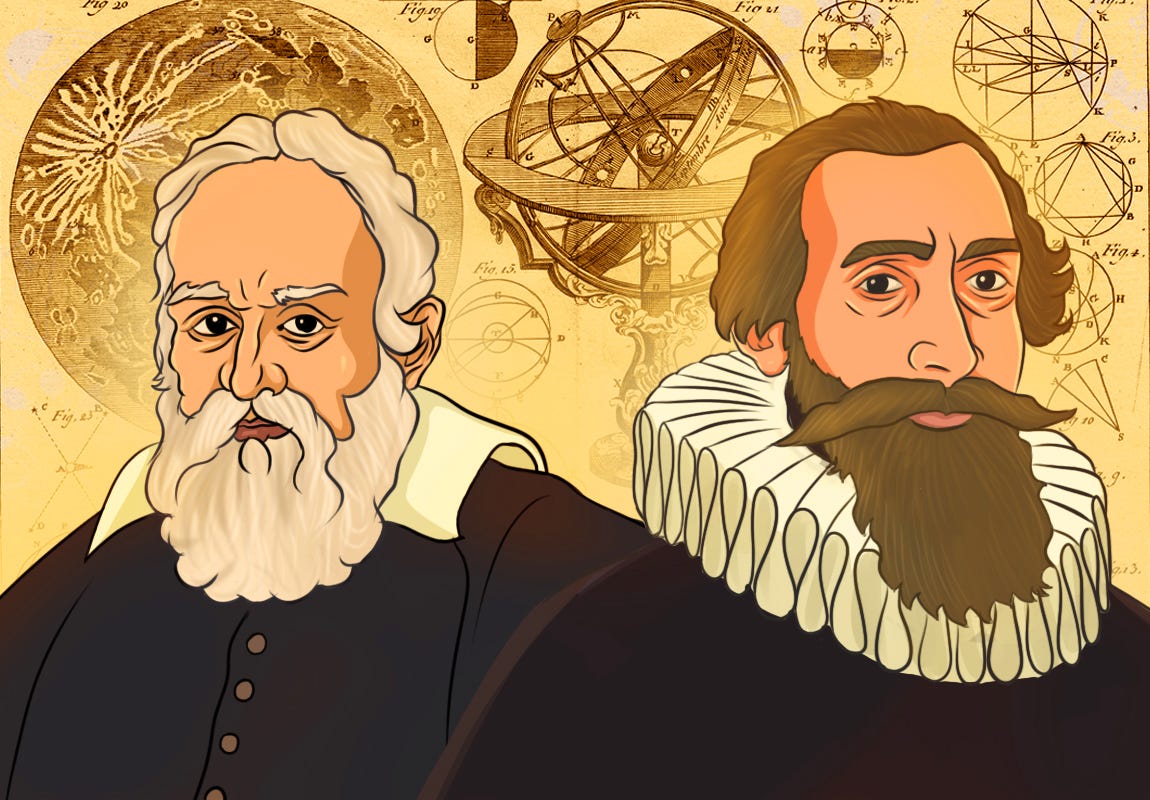Johannes Kepler (1571-1630)
Tycho Brahe was able to convince the scientific community about the need for better tools for scientific research and progress. Following Brahe's death in 1601, the details of his experimental observations and invaluable notes were passed on to his assistant, Johannes Kepler, an astute mathematician.
Kepler was a brilliant student in those days. He had proved his mettle in mathematics and astronomy. In 1600, Kepler arrived at Brahe’s observatory as an assistant. After Brahe’s death the following year, Kepler was positioned to continue his research and take over the observatory. Two decades of Brahe’s work – crucial astronomical information, and notebooks documenting the positions of the planets, including Mars – provided Kepler with everything he needed to find the planets’ orbits. Kepler introduced three important laws regarding the motion of planets.
Kepler’s laws of planetary motion
After long periods of observation of Mars, Kepler discovered that the orbit of Mars around the Sun was elliptical. Kepler’s first law of planetary motion states that the orbits of the planets around the Sun are elliptical and that the Sun is located at one of the two centres of the ellipse.
Kepler’s second law of planetary motion was based on his discovery that a hypothetical straight line connecting the Sun and a planet, always passed through an equal area, in equal lengths of time. According to this law, the closer a planet gets to the Sun, the faster the planet would travel; and the farther a planet is from the Sun, the slower the planet would travel. Only then would it be always possible to cover an equal area in equal time.
According to Kepler’s third law of planetary motion, the square of the planet’s orbital time is equal to one-third of the distance from the Sun to the planets.
Kepler’s three laws of planetary motion helped science define the orbits of the planets around the Sun. In his book titled Harmonies of the World, which introduced the third law of planetary motion, Kepler states: “I finally found it, and my expectation that there would be harmonies at all, even at the microscopic level in the motion of the universe proved to be correct. They move together more perfectly than I previously thought.”
Galileo Galilei (1564-1642)
Galileo Galilei was one of the few individuals of his times who engaged with scientific content and methods. Galileo’s contributions were mainly in the fields of astronomy and physics. He is widely regarded as the founder of experimental science.
Galileo initially studied medicine but later became interested in mathematics and natural philosophy. He was one of the greatest thinkers of all times.
Galileo was the first person to observe craters and mountains on the Moon.
Many remember Galileo for using telescopes to detect unexpected imperfections in space. In 1609, Galileo built his first telescope. His initial observations through the telescope were published the following year in the book The Starry Messenger. Throughout the book, he talks about the need to change old-fashioned views about astronomy. In this book, he challenged the ideas put forward by early thinkers, including Aristotle.
Galileo was the first person to observe craters and mountains on the Moon. He was also the first to observe the peculiarities of Saturn’s atmosphere. Galileo was also the first to see sunspots.
All of these discoveries challenged the view held at that time, that celestial objects were perfect spheres. He recorded information about many stars that could not be seen with the naked eye. He discovered 80 new stars near the Orion Belt and that the Milky Way is a cluster of innumerable faint stars. All these findings contradicted the findings of Aristotle and other ancient scholars.
Galileo discovered that Jupiter had four Moons. These are also known as Galilean Moons. In his book The Birth of a New Physics, scientific historian I. Bernard Cohen writes about Galileo thus: “Not only did Galileo discover the mountains on the Moon but he also measured them. He tried to measure any kind of phenomenon he could find. That was the hallmark of Galileo as a modern scientist.”
Galileo’s publication of his discoveries and his support for the controversial Copernican model of the solar system led him to face trial for blasphemy. Galileo indirectly supported the Copernicus model in a book published in Italian in 1632. He was tried in 1633.
Unlike his predecessors and contemporaries, Galileo sought to discover the mathematical laws behind the motion of objects.
Galileo had earlier assured the Church that he would not support the Copernican model, so he was placed under house arrest for blasphemy. He was pressured to reject the Copernican model. He was under house arrest until he died in 1642.
In 1992, the Church reconsidered the case and acquitted Galileo of all charges of blasphemy. However, this was 350 years after Galileo’s death!
Unlike his predecessors and contemporaries, Galileo sought to discover the mathematical laws behind the motion of objects. It was very important for describing the Earth’s movements.
It was a time when the development of artillery was in full swing. There was a great deal of military research going on at the time about the movement of artillery and cannonballs. The subject also attracted philosophers. Aristotle had said that heavier objects would fall faster than lighter ones, but Galileo proved him wrong. Galileo was said to have dropped two balls from the Leaning Tower of Pisa. While this could be a fabricated story, he certainly was the kind of person who was known to have conduct such experiments. At that time, there were no systems or tools to record accurately the distance travelled and the time taken by an object falling freely. Galileo devised many innovative techniques in this regard and made several discoveries related to the movement of objects on the Earth.
Dear teachers, in this article we discussed four important scientific figures who lived in the 15th and 16th centuries – Nicholas Copernicus, who first introduced the Sun-centred solar system model; Tycho Brahe, who improved astronomical observation and used his advanced astronomical instruments to verify the accuracy of his findings; Johannes Kepler, who discovered that planets have elliptical orbits from Brahe’s findings; and Galileo Galilei, who came up with mathematical explanations for the movements of the Earth. These are excellent examples of the scientific revolution in which one person’s discovery is elevated and taken forward or disproved by another. That is how science developed: through a myriad of contributions made by scientists, both big and small. Like we have seen, today’s views and truths can be corrected tomorrow, with a scientific temperament which is enabled by better technologies and tools . Let the younger generation grow up knowing this.
Now put on your thinking hats and think about the following questions for a couple of minutes.
How would you describe the term “planetary motion” to your students?
Can you think of how Brahe Brahe’s research helped Johannes Kepler in developing his laws of planetary motion?
How would you describe the contributions of Johannes Kepler and Galileo Galilei in the field of astronomy?
Write down your thoughts and discuss them with your students, children and your colleagues. Listen to their views and compare them with your own. As you listen to others, note how similar or different your views are to others’.
Thank you for listening. Subscribe to The Scando Review on thescandoreview.com.
Happy Teaching!













Geniuses Who Revolutionised Astronomy– Part 2